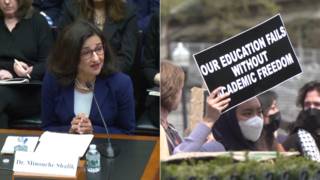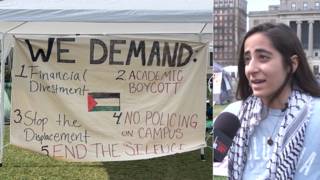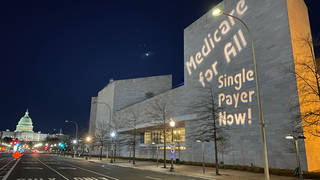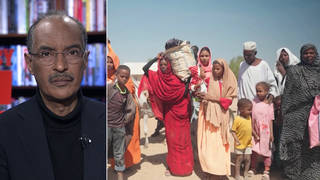
Related
Guests
- David Hayes-Bautistadirector of the Center for the Study of Latino Health and Culture at UCLA School of Medicine.
Throughout the coronavirus pandemic, Black and Latinx people in the United States have died at higher rates, and new data shows that they are getting vaccinated at much lower rates than white people. The Centers for Disease Control and Prevention reports more than 60% of those vaccinated were white, while just 11.5% were Latinx, 6% were Asian, and just over 5% were Black. The CDC data is based on details gathered during the first month of the U.S. vaccination campaign that saw nearly 13 million Americans get a shot, though race and ethnicity was only known for about half of the recipients. Black and Latinx people continue to face a disproportionate risk for COVID-19 in their jobs as essential workers and are more likely to have preexisting conditions. “What we’re seeing illustrated is about 150 years of medical neglect,” says Dr. David Hayes-Bautista, director of the Center for the Study of Latino Health and Culture at UCLA School of Medicine. “These disparities didn’t suddenly appear nine months ago at the beginning of the pandemic. These disparities have been built in, decision by decision.”
Transcript
AMY GOODMAN: January marked the deadliest month yet of the coronavirus outbreak in the United States. Black and Latinx people in the United States continue to die from the virus at higher rates. Now new data shows they’re getting vaccinated at much lower rates than white people. The Centers for Disease Control and Prevention reports more than 60% of those vaccinated so far are white, while just 11.5% are Latinx, 6% Asian, and just over 5% Black. This comes as many Black and Latinx people face a disproportionate risk of exposure to COVID in their jobs as essential workers and are more likely to have preexisting conditions.
The CDC data was gathered during the first month of the U.S. vaccination campaign, and race and ethnicity are only known for about half of the nearly 13 million recipients. At a press conference Monday, the head of the Biden administration’s Health Equity Task Force said more data is needed. This is Dr. Marcella Nunez-Smith.
DR. MARCELLA NUNEZ-SMITH: We cannot ensure an equitable vaccination program without data to guide us. And the CDC will be releasing additional data regarding race and ethnicity and vaccine uptake soon. But I’m worried about how behind we are.
AMY GOODMAN: Here in New York City, just 11% of COVID-19 vaccination so far went to Black people, who represent 24% of the population, and 15% went to the Latinx population, who make up 29% of the city’s population, even in predominantly Latinx neighborhoods where vaccination sites reported high numbers of white people from outside the community getting the shot. Mayor Bill de Blasio held a news conference on Sunday and said the disparities are unacceptable.
MAYOR BILL DE BLASIO: What we see is a particularly pronounced reality of many more people from white communities getting vaccination than folks from Black and Latino communities.
AMY GOODMAN: Across the country in Los Angeles, the number of Latinx patients dying daily from COVID-19 has shot up by 1,000% since November. Latinx people are now succumbing to the disease at a rate over one-and-a-half times that of all Los Angeles residents.
And that’s where we go now to speak to Dr. David Hayes-Bautista, distinguished professor of medicine and director of the Center for the Study of Latino Health and Culture at the David Geffen School of Medicine at UCLA.
Dr. Hayes-Bautista, thanks so much for joining us again.
DR. DAVID HAYES-BAUTISTA: My pleasure.
AMY GOODMAN: One thousand percent increase in deaths of the Latinx population in Los Angeles. Can you explain what’s happening?
DR. DAVID HAYES-BAUTISTA: Oh, it’s quite simple. What we’re seeing illustrated is about 150 years of medical neglect of Latino amongst other communities. And in California, all populations of color have much higher death rates than non-Hispanic white, which tells us a lot about where the medical resources are and aren’t.
But particularly for Latinos, as essential workers who have kept the state going, the farmworkers who kept the state fed, the truck drivers, the packing house workers, the food industry workers, etc., the fact that they have worked during the early days of the pandemic — we didn’t consider them essential workers. We didn’t provide them personal protective equipment. They rarely have health insurance anyway, very low-wage, so that the coronavirus was able to eat its way through them very quickly.
Your average Latino household across the country has more wage earners per household than non-Hispanic white. So you have more adults leaving the house every morning. They cannot do their jobs from the safety of their living rooms, because they don’t have those kind of jobs. You cannot grow strawberries in your living room. You cannot pick peaches in your living room. Thus they become more exposed to coronavirus. They are more likely to bring that into the household. Latinos have twice as many children per household, and children are often asymptomatic. These are the conditions that the coronavirus just loves. It’s very opportunistic.
It’s not because they’re Latino that the rates are so high. It’s because they are in those occupational and living arrangement spaces that coronavirus just loves. A lot of exposure, a lot of people — boom, there it goes. And we’ve been seeing this now for nine months.
JUAN GONZÁLEZ: But, Dr. Hayes-Bautista, that could be understood in terms of the exposure, but now we’re dealing with the issue of the vaccinations in terms of being able to prevent future exposures. And it’s astounding that these inequities continue, not just in California and New York. Texas, which is 40% Latino, Latinos represent only 9% of the people who have been vaccinated so far, even though the Lower Rio Grande Valley is probably the worst place right now in terms of infections in the entire country. How do you explain the disparities in the vaccination process now?
DR. DAVID HAYES-BAUTISTA: Well, again, we have to remember, these disparities didn’t suddenly appear nine months ago at the beginning of the pandemic. These disparities have been built in, decision by decision, politically, in terms of medical education, where to place medical resources, etc. Only now we’re seeing them — basically, those chickens come home to roost with the pandemic. Unfortunately, Latinos and other populations of color are paying the price for this maldistribution and limited access to medical resources, in any case. So it’s just making a bad situation multiplied even worse.
The vaccination rate is very, very low in California amongst Latinos and most populations of color. So, the very populations that have helped keep the state together, kept it fed — if you remember the early days of the pandemic, when people were fighting in the grocery stores over paper towels or toilet paper, I keep saying, imagine if you were fighting over the last bag of potatoes in that store. That would have been some serious fighting. Thanks to farmworkers, we never got there. But the farmworkers have paid a price, because we have neglected them, consistently, for over a century and a half.
JUAN GONZÁLEZ: And in terms of the recent explosion in deaths — because you did a paper that tallied the high death rates among Latinos between May and November. But since November, it’s exploded 1,000%. What’s happening there?
DR. DAVID HAYES-BAUTISTA: Well, that was 1,000% in some areas of Los Angeles. We got 15 million Latinos in California. So, we’re looking at the state, because we realize that in some areas — we’re doing work in farmworking communities in Ventura County, and in those small areas, it has just exploded. Overall, between actually October 27th and January 27th, the overall state mortality rate for Latinos has doubled. However, it started in October as five to six times higher than white. And in January, it’s still five to six times higher than white. So, compared to white, yes, the death rate is absolutely huge.
And I am not sure yet that we have peaked. I am on the board of a hospital in East L.A. Ninety-nine percent of its patients are Latino. And we have had increases in admissions over the past four days. We have not seen yet the leveling off that other places may claim to have seen.
AMY GOODMAN: Dr. David Hayes-Bautista, if you could talk about the issue of language and the issue of the directions that are being given to people? We have two different situations, one when people get sick and the other for people to learn about vaccines and not be afraid they’ll be picked up by ICE if they dare to be vaccinated. I wanted to go to an interview we did last month with Odilia Romero, the Zapotec interpreter and co-founder and executive director of the group Indigenous Communities in Leadership, or CIELO, an Indigenous women-led nonprofit in Los Angeles. This is what she said.
ODILIA ROMERO: When you hear the privilege of others, when the essential workers are not getting vaccinated, it’s very heartbreaking. And it is, very personally, very frustrating. Like, I wouldn’t have the words to tell you, like, my feeling of anger at times, because I see Indigenous communities at the forefront. From the farm — from the agricultural fields to the hospitality industry to the cleaners, we are there. And we don’t have access to the vaccine. …
The loss of lives, people being infected, you know, and the loss of knowledge is there, right? Some of the elders have passed away, and there goes a whole worldview. Just last week, someone in the community died. She knew the stories of migration. She was one of the first women that came to the U.S., you know, and she brought a lot of other women. And all the stories are gone. And the language is dying with COVID more than ever, especially here in L.A. with the elders.
AMY GOODMAN: At places like Standing Rock Reservation, Native American leaders have prioritized the language keepers as those to be vaccinated first, those who speak Lakota and Dakota. But this goes to a number of questions. What languages are people being instructed in, where to go if they have COVID-19, where to go if they have the vaccine? Also, essential workers being prioritized when it comes to vaccines, not just even getting the vaccine, but the fact that they are on the frontlines, whether we’re talking about farmworkers in the fields, people who work in grocery stores, people who keep the whole society alive every day, somehow being protected and reached out to proactively, as opposed to them figuring out where they can go?
DR. DAVID HAYES-BAUTISTA: Absolutely. Well, I have to say, the bulk of the information is provided in English. Now, we have to remember, Spanish — medical services have been provided in Spanish in California for 251 years, so this is not like something that suddenly happened. This is simply part of California history. And the Spanish spoken in California has been highly Indigenous-inflected. In 1805, the Spanish spoken here is — yes, it was Spanish, but also included Nahua — that is Aztec — Otomi, Lipan and Comanche as part of the larger spoken language.
Indigenous who arrive from Mexico and Central America, however, are not considered Indians by the U.S. government. They’re just simply immigrants, are not eligible for services under the Indian Health Service. So they’re kind of left out with nothing underneath them except their own communities. We lack interpretation in Spanish. By the way, also in Vietnamese and Filipinic languages and Southeast Asian languages, all underrepresented, much less the Indigenous languages. And yet it is the Indigenous communities that are increasingly forming the backbone of farmworking in California. And our society, our institutions simply hasn’t learned how to communicate with the ones who feed them.
JUAN GONZÁLEZ: And, Dr. Hayes-Bautista, I’m wondering, in terms of the dissemination of the vaccine, what your thoughts are on the best way to move forward in an equitable fashion. Clearly, there have been these attempts by some local governments to put everything through existing hospital systems. There have been the attempts to open up arenas or stadiums, basically on a not “first come, first serve,” but in a general shotgun approach. Do you think that there has to be a more directed approach into particular industries and jobs or by ZIP code? What would you think is the best way to assure greater equity in the vaccination process?
DR. DAVID HAYES-BAUTISTA: Well, the extent to which we rely on the existing institutions of healthcare delivery, we’re in trouble, because those existing institutions have not adequately served minority communities in this state for 150 years. However, there are alternative organizations, the community-based clinics, for example, who are a large major provider of healthcare services, particularly in California. We have the community organizations.
And also we need to deal with the lingering effects of the Trump administration. Just last Sunday at a vaccination event at Dodger Stadium, a group of Trumpy supporter anti-vaxxers actually disrupted and caused closure of that effort for over an hour as they were trying to persuade people not to become vaccinated. And, by the way, their organizing instructions said, “Oh, don’t bring your Trump flags. We don’t want Trump to get any blame for this.”
So, we have very confusing messages. We have confusing priorities. Up until a few weeks ago, essential workers were a priority. Now the state has shifted to elderly. Well, the essential workers are largely minority. Elderly are still largely white baby boomers. So it’s a very confusing, confusing lack of a plan. But the ones paying the price are the ones who have for 150 years kept the state clothed, fed and functioning.
AMY GOODMAN: I wanted to talk about what’s happening here in New York. The governor’s Department of Health, nine top leaders of the Health Department have quit amidst the rift of what he’s doing in laying out the vaccine rollout. Bill de Blasio, the mayor, held a news conference Sunday admitting the terrible figures on who actually is getting access to the vaccine. The numbers: 11.5% of the Latinx population — 60% of those getting vaccinated were white, 11.5% Latinx, 6% Asian, just over 5% Black. Even as vaccination sites are put into communities of color, overwhelmingly, people — white people are going to those sites and getting vaccinated.
The New York Times today has a major editorial on this disparity and what has to happen. The City newspaper did a very interesting piece talking about the NewYork-Presbyterian Hospital at its Washington Heights medical center complex, a Latino woman, Olga, coming up and encountering one language barrier after another. No one there spoke Spanish. The reporter was asked to do the translating for the paper. As she said, “We don’t have access to internet. We try to make our online reservations. We can’t. And then when we get here, no one can help us.” What about that issue of these online rollouts of vaccines, and who gets access to that and who doesn’t?
DR. DAVID HAYES-BAUTISTA: We’ve done a study — a couple of studies, actually — on telemedicine, one particularly on telemedicine and COVID, and how these function. And it turns out that most of the telemedicine efforts that we have, for example, out of the School of Medicine, assumes that you have one screen, and it’s sitting on a desktop with broadband access. A lot of Latino families don’t live in that situation. What they tend to use is something like WhatsApp. But our systems don’t funnel into WhatsApp, which is something more accessible.
So, again, we have built up our system on the assumption that everyone behaves kind of like in Beverly Hills, has access to all those wonderful services. Most of the population does not. We didn’t even think of that at the beginning of the pandemic. Farmworkers didn’t receive PPE. Until even now, many farmworkers do not receive PPE from their employer or from the state.
So, follow the admissions committees’ decision — who gets into the medical schools, who graduates — for the past century, and it has not been primarily communities of color or students of color. And now we’re reaping the results of those decisions to reduce medicine to just certain — to be able to serve certain communities and just simply ignore the others.
JUAN GONZÁLEZ: And, Doctor, what about the situation, that segment of the Latino population that is undocumented, in terms of access to services, even access to the vaccine? We’re told it’s supposed to be free, but what’s the actual situation from what you can tell?
DR. DAVID HAYES-BAUTISTA: The message once again is horribly confusing. Is it free? Is it not? Do you go to a county facility? Do you go to a private facility? Will you get a bill? Will you have insurance? Will you be considered having used public facilities if you get a shot? People just — the messages are very, very confusing. And for a lot of folks, given that it’s already difficult to find a physician who speaks your language, that you can pay if you don’t have insurance, much less than the idea of: Is this going to be a public charge again? So, I can understand why people are really confused. And in the best of cases, the best thing to do, they think, is, “Well, do nothing. How can it get worse?” Well, it can. COVID spreads like a communicable disease, but it kills like a chronic disease. It’s very different.
AMY GOODMAN: Dr. David Hayes-Bautista, can you talk about the protest at Dodger Stadium over the weekend, the COVID-19 vaccination center, one of the biggest in the country, being shut down temporarily by people who are against vaccines and also the far right? The significance of this? And what messages are the Latinx community getting around the safety of these vaccines?
DR. DAVID HAYES-BAUTISTA: Well, among others — and I was not there, so I’m relying on other reports that I’m getting from people who were — is that this also included this free mask — or, mask-free California coalition. They’ve come together, and apparently, about two weeks ago, they went through the Beverly Center, which is a very upscale shopping center right at the edge of Beverly Hills, and, in groups, entered stores without masks on, and shouting match. There were tug of wars, etc. So it’s not aimed only at Latinos. But there is this very strong element of resistance to doing any public health measures as an infringement upon their freedoms. And I keep saying, “Well, you have every freedom to kill yourself by not wearing a mask. You do not have the freedom to kill me by breathing your germs on me.” But that message has not gone through. And, of course, it’s being stimulated by the remnants of the Trump administration.
So, once again, we have a very confusing situation. People were waiting in cars to get vaccinated. I have heard that some finally got frustrated, and they left the line, so they’ve lost a chance for a vaccination. So, again, because we did not have a strong plan from the federal government for nine months — in fact, we had an administration that basically turned its back and said it was a hoax and it was going to go away, which it has not — it was left to the states. Many states leave things up to the counties. It is horribly confusing. Although the one consistent message that many undocumented have heard is: “Use public services, you can never become a citizen, even though you fed us during the pandemic.”
AMY GOODMAN: And is there fear about ICE picking them up if they get on a vaccine line?
DR. DAVID HAYES-BAUTISTA: I don’t know about a vaccine line, but there was a story earlier this summer out of Denver that was in the Spanish-language medium about a COVID-positive person who was undocumented, was actually admitted to a hospital in Colorado. ICE went in and picked him out. I don’t know what happened, but ICE has been sending known coronavirus-positive refugees back to the countries of origin, Mexico and Central America, thereby seeding the pandemic in the countries with the least resources to respond to the pandemic.
AMY GOODMAN: Well, I want to thank you, Dr. David Hayes-Bautista, for joining us, distinguished professor of medicine and director of the Center for the Study of Latino Health and Culture at the David Geffen School of Medicine at UCLA in Los Angeles.
This is Democracy Now! When we come back, big news is breaking around the Sputnik V — that’s the Russian vaccine — that it’s 92% effective. We’re going to go to Moscow to speak with a New Yorker reporter and also about the massive protests that took place this weekend, over 5,000 people arrested. Stay with us.












Media Options